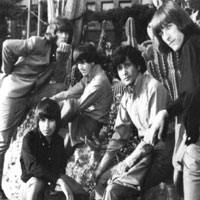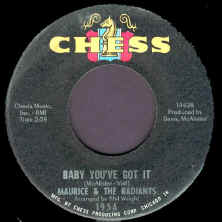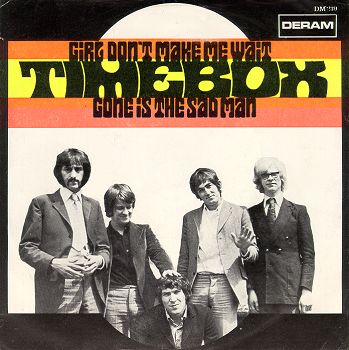 The Sir Douglas Quintet
The Sir Douglas Quintet
Augie Meyers (far left), Doug Sahm (far right)
Back in early 1990, I had just returned from a grand tour of the South (with my brother Chris), in which we visited friends, family and tourist traps in Atlanta, Chattanooga, Memphis and Nashville. A fine time was had by all, and I returned to NJ well rested.
The Monday after getting back, having affixed an Elvis sticker to the trunk of my Chevy Spectrum (in the most ironic sense possible), I left for work.
About a half mile from work, I leaned over to tune the radio, and when I looked up I was a very short distance from the back of a car that has stopped to make a left turn. Naturally, I slammed on the brakes, but was way too close to stop, and promptly rammed that car, almost pushing it into oncoming traffic.
That car was totaled.
My car was totaled.
I had a big cut on my forehead and some sore muscles, but was otherwise OK (thankfully, so was the person in the car I hit).
The whole episode was a huge drag, which would haunt me financially for years to come (I’ll save that story for another time).
My car was a few months from being paid off, and I hardly had the money to go out and buy a new one.
Well…my Dad came and picked me up at the hospital, and I went to spend the night at my parents house.
So, I’m sitting on my Mom’s couch, aching, generally feeling sorry for myself and dreading what kind of trouble (financial and otherwise) I was going to be facing when this all shook out (like, was I gonna get sued etc. and how as I going to get to work without what Long Duck Dong decribed as an “auto-mo-beeeeellll…”). Utterly depressed.
Then, out-of-the-blue, a friend (who in the ensuing years has just about lost his mind after being ground up by the teeth of an adulthood he was ill equipped to deal with, and thus shall remain nameless) called and asked if I wanted to go see the Sir Douglas Quintet at Maxwell’s in Hoboken.
Well, hell yes.
I think I had known about the gig, but had written it off because I was supposed to be working that night. Serendipity, knowing what was good for me, stepped in and destroyed my car - and the car of another - so I might be there. Mysterious ways indeed.
My pal came and got me, and we drove to Hoboken where I figured I could find succor and consolation in a mixture of righteous music and beer. All the way up I bitched and moaned about how terrible the fallout from this accident was going to be (completely ignoring how lucky I was that no one had been seriously hurt), and wondering what I was going to do. The irony in the fact, that I was being chauffered to this show by one of the WORST drivers this state has ever known (the kind of driver that makes you wonder how they could possibly keep getting insured) was lost on me.
We managed to arrive safely in Hoboken, and right after finding a parking space managed to run into a couple of very good friends, who, after hearing my tale of woe, took a page from the friend handbook, and promptly got me high.
Things were looking up.
Not long after that we all walked up the hill to Maxwells.
For those who don’t know, for a while Maxwells was the greatest rock’n’roll bar in America (maybe the world). One of the smallest music rooms around (which despite it’s size managed to host almost every major alternative - in the broadest sense of the word - act of the 80’s/90’s), fantastic selection of beer, quiet neighborhood (almost zero chance of getting mugged/robbed or having your car stolen), and it was in New Jersey.
Anyway…we all walked into the bar, said our hellos to a few familiar faces and proceeded to enter the back (music) room. I found a bar stool and began to drink.
So you’re reading this and thinking “So what? Glad to hear you managed to find some friends with whom to become intoxicated following your careless driving episode, but why should I care?”
Man, that was cold….
But I digress. I was really, really depressed (did I already say that?). I knew, despite the fact that I was “up and around”, that the fallout from the accident was going to suck, and I didn’t really have any money, and blah blah blah….you know?
The fact that in the space of a few hours I had managed to hook up with some good friends, get high, order a beer and sit waiting for a true hero of American rock’n’roll music to take the stage, was – as I saw it – a significant turnaround.
The key part of that run on sentence, was the phrase “true hero of American rock’n’roll music”. The Sir Douglas Quintet or more specifically Doug Sahm was (at least in 1990) a relic of a bygone era. One hit wonders who jumped onto the national stage in 1965, and promptly fell off again.
That’s the short version.
The longer version – which you will always get here – sees the many incarnations of the band continuing to make great music on through the end of the 60’s and right up to the present.
Doug Sahm started making records as a 14 year old in mid-50’s Texas, recording several R&B inflected sides before the birth of the Sir Douglas Quintet. That this birth took place in the diseased – though musically prolific mind – of Huey P. Meaux (otherwise known as the Crazy Cajun), is important. Meaux, deciding that he needed something to compete with Beatle-fueled Anglophilia, decided to give the band a decidedly English sounding name, and put them on the cover of their first album shrouded in shadows (to hide the fact that the Quintet was composed of a couple of Texas hillbillys and three Chicanos, and not another gang of tea and crumpeteers from the old sod). Even more remarkable is the fact that this ruse held together even though the miraculous product of this collaboration sounded like Ray Charles fronting a Tex-Mex band.
‘She’s About A Mover’ hit the Top 40 in 1965 and got the Quintet on Shindig, Bandstand etc, and launched Doug Sahm and his compadre Augie Meyers (he of the SDQ’s trademark Farfisa organ) on a 40 year odyssey. That the tune was a bit of genius is undeniable. That the pop charts were not ready for a continued assault from these synthesizers of R&B, rock, norteno, cojunto etc is similarly carved in stone.
The band dropped off the charts (though recording several excellent singles for Meaux’s Tribe label) and following a 1966 pot bust Sir Doug put some flowers in his hair and headed for that Shangri-La that Sid Dithers once referred to as San Francisky.
There, in 1969 a reconstituted SDQ crafted the absolutely brilliant ‘Mendocino’ LP, grazed the Top 40 yet again and went on to make a lot of outstanding, moderately successful records for a variety of labels.
In the early 90’s, Sahm and Meyers hooked up with Freddie Fender and Flaco Jimenez to form the Texas Tornados, and had a few years of bonafide country stardom (and excellent albums) ahead of them.
Anyway….When the SDQ took the stage that night, I just sat there and basked in the glow of great music, played and sung by great musicians in a tiny little bar in Hoboken, NJ (probably smaller than the places they played 25 years before back in Texas). I was transported (as all truly great music ought to be able to do) and for about 2 hours - as the SDQ laid down some of the most authentic “soul” music as has ever been played – my smashed up car (and the car that we had joined together to smash) and the cut on my head and the ache in my back and my uncertain future all vanished. It was just me, my friends, 75 to 80 other people and the Sir Douglas Quintet experiencing the kind of communion that happens on Friday nights in clubs all over the world, where people band together with their beer and their music and file their troubles away, at least for a night. Only here, in Hoboken, the music was so much better.
It certainly helped that they ended the show with a brilliant medley of 'She's About A Mover', the 13th Floor Elevators 'You're Gonna Miss Me' and ? & the Mysterians '96 Tears' (kind of a Rosetta Stone of Texas 60's punk).
Maybe a year later, when Sahm and Meyers were touring as part of the ‘Last Real Texas Blues Band’ (with pigtailed Texas sax wizard Rocky Morales along for the ride) I had a chance to rap with Sir Doug (and Augie) at the bar, and he was every bit as cool as you’d imagine. Funny, down to earth and get this…he could not stand George Bush (that’s Daddy Bush, but I imagine had he lived to see Dubya in the White House he wouldn’t have dug him much either).
Sir Doug passed away in 1999 (he was only 58). When I heard he was gone, I remembered how he and his music lifted me up that night in 1990, and I smiled.

 Maurice McAlister and Mac McLauren
Maurice McAlister and Mac McLauren






